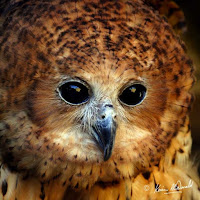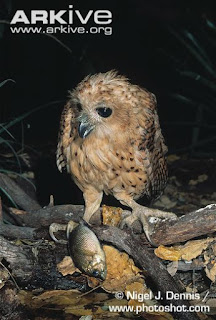 |
| Pel's fishing owl. |
The Pel’s fishing owl was named after the Dutch governor,
Hendrik Severinus Pel, of the gold coast between the years of 1840 and 1850. A
shy and elusive owl, it would be a magical and unforgettable experience to spot
one.
With an average wingspan of 153cm, a length of 51 to 61cm
and an average weight of 2188 grams makes the Pel’s fishing owl one of the
largest owl species on the planet. They are said to be the fifth heaviest owl
in the world.
These are ginger coloured owls with a round head and
haunting like black eyes. Their underparts have dark bars and their underside
is a paler colour. Females are usually a paler ginger colour than their male
counterparts while owlets have a whiter coloured body and head, only growing
their adult plumage by the age of 15 months old.
They do not have the characteristic facial discs, like most
owls, because hearing is not important when locating their underwater prey. Their
feathers are not as soft and lights as other owls as they do not need to be
silent for hunting underwater prey.
Habitat
These owls live in sub-Saharan Africa, found in countries such as Senegal, Somalia, Namibia
 |
| Pel's fishing owl in flight. |
Pel’s fishing owls make their homes in large trees along the
banks of rivers and on the edges of lakes, swamps and in wetlands. They do not
participate in seasonal movement like some birds.
Behaviour
Owls are nocturnal animals, who are more active and vocal
during the night under the cover of the darkness. Pel’s fishing owls are most
active on moonlit nights however they are sometimes active during the day. The
male and female pair will usually roost together during the day and at dusk
leave to perch on branches near or over the water.
Vocals
They are mostly vocal during the night and are most vocal an
hour before dawn breaks. Their calls have been described as bone chilling and haunting and have been compared to someone calling from the bottom of a well.
 |
| With fish for a meal. |
Their hoots are used as communication calls and during the
breeding season they perform duets with their partners. Males have a deep and
rumbling call which are repeated six to seven times within a minute. Females
have a higher pitched call that is usually only a single hoot and then followed
by a double hoot. Their calls can be heard up to 3 kilometres away.
Diet
Pel’s fishing owls eat mostly fish but will indulge in
eating frogs, crabs, mussels, insects and even small baby crocodiles.
They detect their prey using sight by watching for ripples
made by fish as they near the surface of water. Their toes are covered in spiky
scales to help hook and catch their fishy meals. Unlike most owls, Pel’s
fishing owls lack feathers on their legs and toes, to minimise the amount of
plumage to get wet while hunting.
Reproduction
These owls pair up in monogamous couples and claim a
territory near water by using stern hooting.
 |
| The haunting look of a Pel's fishing owl. |
The pair breeds during the dry season when the water is
shallow and clear. They set up home using a natural hollow in an old tree and
do not add any extra nesting material. The female incubates the laid eggs
(weighing 85g each) for up to 32 days while the male provides the food. Sadly
usually only one of the two eggs survives.
The chick that survives fledges the nest at 68 to 70 days old and will continue
to live in their parent’s territory until they are 6 to 9 months old. Chicks
grow their true feathers by the time they are 10 months of age.
Did you know?
The Pel’s fishing owl will fluff up their head feathers when
distressed making its head appear larger.

No comments :
Post a Comment